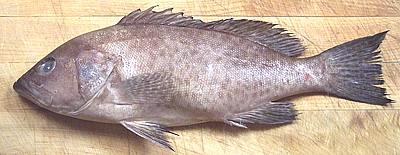 [Epinephelus areolatus]
[Epinephelus areolatus]
This Indo West-Pacific fish is found from South Africa to Fiji and north as far as Japan. It can grow to 18 inches and 3 pounds but the photo specimen was 13-1/2 inches and weighed 1 pound. This fish is both caught wild and farmed. It is kosher and not considered threatened.
More on Grouper Family.
The flesh of this grouper is very white and delicate in flavor. Fillets hold together well enough for poaching if handled gently and they flake apart very easily on the plate. It is easy to bone completely and an ideal fish for the most delicate sauces.
Grouper is called for in many cookbook recipes and its characteristics make it desirable for upscale restaurants so it is often expensive. This grouper tastes about the same as, say, Strawberry Grouper but is not so stunning in appearance, and it is now farmed so prices tend to be quite reasonable.
Scales: This fish is covered with moderate sized but hard and tightly adhering scales that take some energy to scrape off, and they fly all about as you do so. They are particularly a problem at the edges and you may need to pick some off with long nose pliers or shave them off with the sharp edge of your prep knife.
Cleaning: This isn't the easiest fish to clean as there are a lot of tough membranes inside. You'll want to cut the gill arches loose with your kitchen shears because they pull very hard.
Fillet: This is not a difficult fish to fillet, but dive sharply under the collar because there's quite a bit of flesh there. When you get down to the rib cage it's easiest to cut the ribs from the backbone and pull them from the fillet. There are some long sharp centerline spines for the length of the body cavity you should pull out with your long nose pliers. Pull straight forward as usual.
Yield: A 1 pound fish yielded 1/2 pound of skinless fillet (50%), rather better than some other groupers.
Skin: The skin shrinks a lot when cooked so must be removed. Fortunately it's a relatively easy fish to skin using the usual long knife and cutting board Method.
Stock: This is an excellent fish for stock. There will still be quite a bit of flesh on the head and the bottom of the collar which is difficult to recover due to the bones. Stock made from the head, fins and bones is mild and quite usable. For details see our Fish Stock page.
sf_grouparz 060828 - www.clovegarden.com